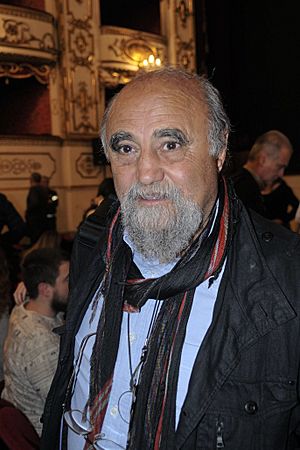Abbas (photographer) facts for kids
Quick facts for kids
Abbas Attar
|
|
|---|---|
| عبas | |
 |
|
| Born | 29 March 1944 Khash, Sistan and Baluchestan Province, Iran
|
| Died | 25 April 2018 (aged 74) |
| Nationality | Iranian |
| Spouse(s) |
|
Abbas Attar (Persian: عباس; full name: عباس عطار ʿAbbās ʿAṭṭār; born March 29, 1944 – died April 25, 2018), often known simply as Abbas, was an Iranian photographer. He was famous for his photojournalism, which is like telling stories with pictures. He took many photos of important events in the 1970s, like wars and changes in countries such as Biafra, Vietnam, and South Africa. Later, he spent many years taking pictures to explore different religions around the world.
Abbas was part of several important photography groups. He was with Sipa Press from 1971 to 1973, then with Gamma from 1974 to 1980. In 1981, he joined Magnum Photos, which is a very well-known group of photographers.
A Photographer's Journey
Abbas Attar was born in Iran but later moved to Paris, France. He spent his career using his camera to show the political and social changes happening in many developing countries. Since 1970, his amazing photos have been published in magazines all over the world.
Capturing History
Abbas photographed many major events. He covered wars and revolutions in places like Biafra, Bangladesh, Ulster, Vietnam, the Middle East, Chile, and Cuba. He also created a special photo story about apartheid in South Africa. Apartheid was a system where people were separated and treated unfairly because of their race.
From 1978 to 1980, Abbas photographed the Islamic Revolution in Iran. This was a big change in his home country. He returned to Iran in 1997 after being away for 17 years. His book, iranDiary 1971–2002, shares his personal thoughts and photos about Iran's history.
Exploring Cultures
From 1983 to 1986, Abbas traveled all over Mexico. He photographed the country as if he were writing a story. His book, Return to Mexico, journeys beyond the mask, included his travel diaries. This helped him understand his own style of photography.
Between 1987 and 1994, he focused on the rise of Islam in different parts of the world, from Xinjiang to Morocco. His book, Allah O Akbar, a journey through militant Islam, showed the challenges within Muslim societies. It explored how they balanced old traditions with new ideas and hopes for democracy. This book became even more important after the September 11 attacks in 2001.
As the year 2000 approached, Abbas turned his camera to Christianity. His book, Faces of Christianity, a photographic journey, looked at this religion as a political, spiritual, and traditional part of life.
From 2000 to 2002, he started a project on Animism, which is the belief that spirits live in natural objects. He wanted to understand why old rituals were becoming popular again in our modern, scientific world. He stopped this project after the first anniversary of the September 11 attacks.
His book, In Whose Name? The Islamic World after 9/11 (2009), was the result of seven years of travel across 16 countries. It explored how different groups were trying to influence people's beliefs in Muslim societies.
From 2008 to 2010, Abbas traveled the world of Buddhism. He photographed it with a thoughtful eye for his book, Les Enfants du lotus, voyage chez les bouddhistes. In 2011, he started a similar long-term project on Hinduism, which he finished in 2013.
Before he passed away, Abbas was working on a project to document Judaism around the world.
A film called Abbas by Abbas (2020) was completed just days before he died. In the film, Abbas was asked about his photos. He said, "Let the photos live their lives and keep their mystery."
Abbas Attar died in Paris on April 25, 2018, when he was 74 years old. He left behind a huge collection of photographs that help us understand the world.
See Also
 In Spanish: Abbas Attar para niños
In Spanish: Abbas Attar para niños
- Culture of Iran
- Islamic art
- Iranian art
- List of Iranian artists

